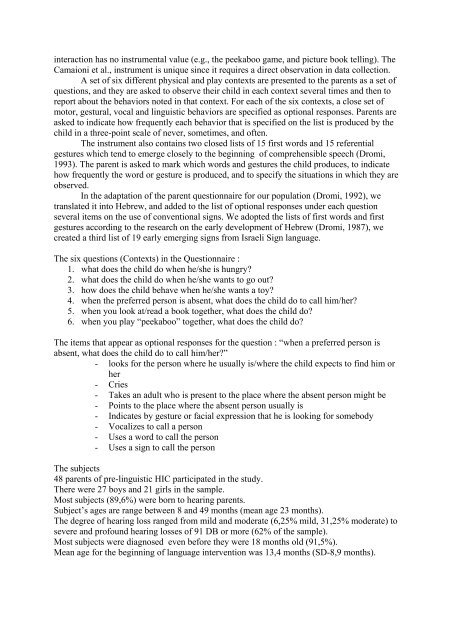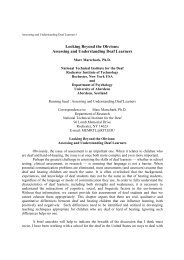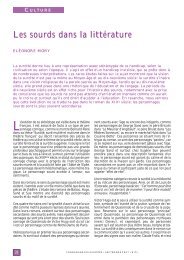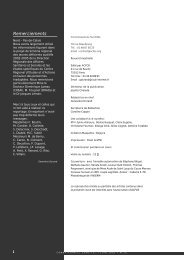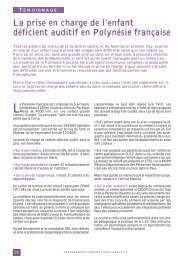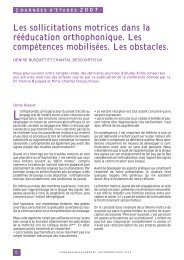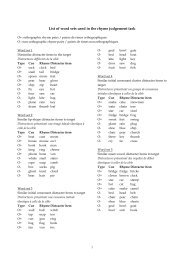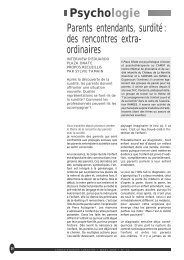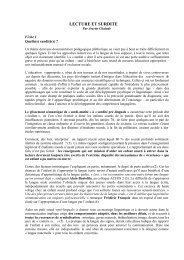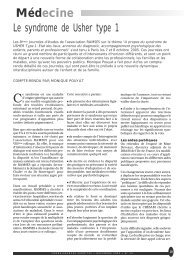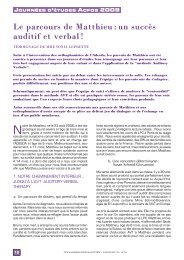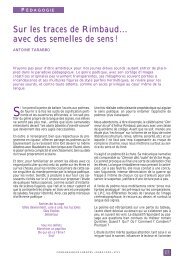A Parent Report Instrument for the Assessment of Pre ... - ACFOS
A Parent Report Instrument for the Assessment of Pre ... - ACFOS
A Parent Report Instrument for the Assessment of Pre ... - ACFOS
- No tags were found...
You also want an ePaper? Increase the reach of your titles
YUMPU automatically turns print PDFs into web optimized ePapers that Google loves.
interaction has no instrumental value (e.g., <strong>the</strong> peekaboo game, and picture book telling). TheCamaioni et al., instrument is unique since it requires a direct observation in data collection.A set <strong>of</strong> six different physical and play contexts are presented to <strong>the</strong> parents as a set <strong>of</strong>questions, and <strong>the</strong>y are asked to observe <strong>the</strong>ir child in each context several times and <strong>the</strong>n toreport about <strong>the</strong> behaviors noted in that context. For each <strong>of</strong> <strong>the</strong> six contexts, a close set <strong>of</strong>motor, gestural, vocal and linguistic behaviors are specified as optional responses. <strong>Parent</strong>s areasked to indicate how frequently each behavior that is specified on <strong>the</strong> list is produced by <strong>the</strong>child in a three-point scale <strong>of</strong> never, sometimes, and <strong>of</strong>ten.The instrument also contains two closed lists <strong>of</strong> 15 first words and 15 referentialgestures which tend to emerge closely to <strong>the</strong> beginning <strong>of</strong> comprehensible speech (Dromi,1993). The parent is asked to mark which words and gestures <strong>the</strong> child produces, to indicatehow frequently <strong>the</strong> word or gesture is produced, and to specify <strong>the</strong> situations in which <strong>the</strong>y areobserved.In <strong>the</strong> adaptation <strong>of</strong> <strong>the</strong> parent questionnaire <strong>for</strong> our population (Dromi, 1992), wetranslated it into Hebrew, and added to <strong>the</strong> list <strong>of</strong> optional responses under each questionseveral items on <strong>the</strong> use <strong>of</strong> conventional signs. We adopted <strong>the</strong> lists <strong>of</strong> first words and firstgestures according to <strong>the</strong> research on <strong>the</strong> early development <strong>of</strong> Hebrew (Dromi, 1987), wecreated a third list <strong>of</strong> 19 early emerging signs from Israeli Sign language.The six questions (Contexts) in <strong>the</strong> Questionnaire :1. what does <strong>the</strong> child do when he/she is hungry?2. what does <strong>the</strong> child do when he/she wants to go out?3. how does <strong>the</strong> child behave when he/she wants a toy?4. when <strong>the</strong> preferred person is absent, what does <strong>the</strong> child do to call him/her?5. when you look at/read a book toge<strong>the</strong>r, what does <strong>the</strong> child do?6. when you play “peekaboo” toge<strong>the</strong>r, what does <strong>the</strong> child do?The items that appear as optional responses <strong>for</strong> <strong>the</strong> question : “when a preferred person isabsent, what does <strong>the</strong> child do to call him/her?”- looks <strong>for</strong> <strong>the</strong> person where he usually is/where <strong>the</strong> child expects to find him orher- Cries- Takes an adult who is present to <strong>the</strong> place where <strong>the</strong> absent person might be- Points to <strong>the</strong> place where <strong>the</strong> absent person usually is- Indicates by gesture or facial expression that he is looking <strong>for</strong> somebody- Vocalizes to call a person- Uses a word to call <strong>the</strong> person- Uses a sign to call <strong>the</strong> personThe subjects48 parents <strong>of</strong> pre-linguistic HIC participated in <strong>the</strong> study.There were 27 boys and 21 girls in <strong>the</strong> sample.Most subjects (89,6%) were born to hearing parents.Subject’s ages are range between 8 and 49 months (mean age 23 months).The degree <strong>of</strong> hearing loss ranged from mild and moderate (6,25% mild, 31,25% moderate) tosevere and pr<strong>of</strong>ound hearing losses <strong>of</strong> 91 DB or more (62% <strong>of</strong> <strong>the</strong> sample).Most subjects were diagnosed even be<strong>for</strong>e <strong>the</strong>y were 18 months old (91,5%).Mean age <strong>for</strong> <strong>the</strong> beginning <strong>of</strong> language intervention was 13,4 months (SD-8,9 months).


